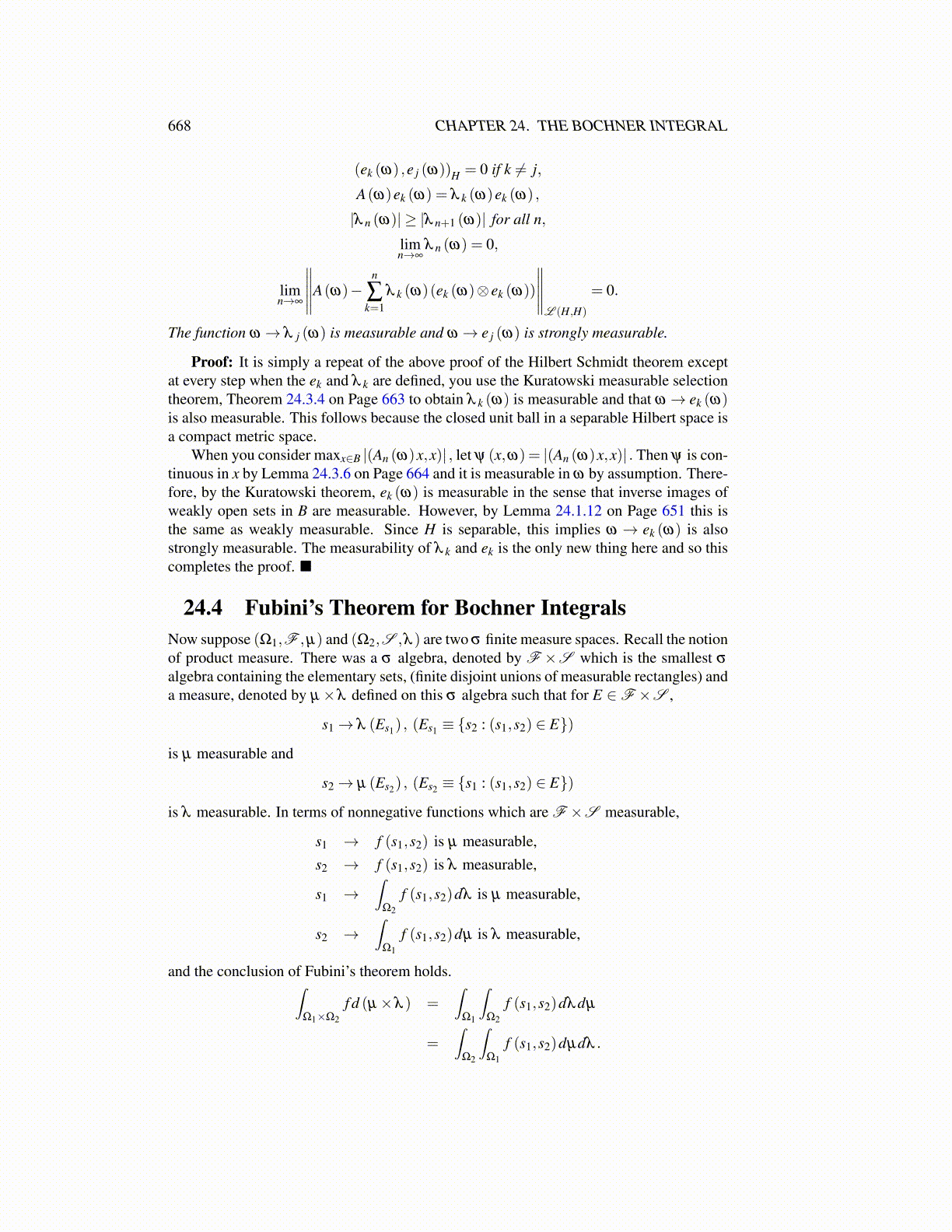
668 CHAPTER 24. THE BOCHNER INTEGRAL
(ek (ω) ,e j (ω))H = 0 if k ̸= j,
A(ω)ek (ω) = λ k (ω)ek (ω) ,
|λ n (ω)| ≥ |λ n+1 (ω)| for all n,
limn→∞
λ n (ω) = 0,
limn→∞
∥∥∥∥∥A(ω)−n
∑k=1
λ k (ω)(ek (ω)⊗ ek (ω))
∥∥∥∥∥L (H,H)
= 0.
The function ω → λ j (ω) is measurable and ω → e j (ω) is strongly measurable.
Proof: It is simply a repeat of the above proof of the Hilbert Schmidt theorem exceptat every step when the ek and λ k are defined, you use the Kuratowski measurable selectiontheorem, Theorem 24.3.4 on Page 663 to obtain λ k (ω) is measurable and that ω → ek (ω)is also measurable. This follows because the closed unit ball in a separable Hilbert space isa compact metric space.
When you consider maxx∈B |(An (ω)x,x)| , let ψ (x,ω) = |(An (ω)x,x)| . Then ψ is con-tinuous in x by Lemma 24.3.6 on Page 664 and it is measurable in ω by assumption. There-fore, by the Kuratowski theorem, ek (ω) is measurable in the sense that inverse images ofweakly open sets in B are measurable. However, by Lemma 24.1.12 on Page 651 this isthe same as weakly measurable. Since H is separable, this implies ω → ek (ω) is alsostrongly measurable. The measurability of λ k and ek is the only new thing here and so thiscompletes the proof. ■
24.4 Fubini’s Theorem for Bochner IntegralsNow suppose (Ω1,F ,µ) and (Ω2,S ,λ ) are two σ finite measure spaces. Recall the notionof product measure. There was a σ algebra, denoted by F ×S which is the smallest σ
algebra containing the elementary sets, (finite disjoint unions of measurable rectangles) anda measure, denoted by µ×λ defined on this σ algebra such that for E ∈F ×S ,
s1→ λ (Es1) , (Es1 ≡ {s2 : (s1,s2) ∈ E})
is µ measurable and
s2→ µ (Es2) , (Es2 ≡ {s1 : (s1,s2) ∈ E})
is λ measurable. In terms of nonnegative functions which are F ×S measurable,
s1 → f (s1,s2) is µ measurable,s2 → f (s1,s2) is λ measurable,
s1 →∫
Ω2
f (s1,s2)dλ is µ measurable,
s2 →∫
Ω1
f (s1,s2)dµ is λ measurable,
and the conclusion of Fubini’s theorem holds.∫Ω1×Ω2
f d (µ×λ ) =∫
Ω1
∫Ω2
f (s1,s2)dλdµ
=∫
Ω2
∫Ω1
f (s1,s2)dµdλ .